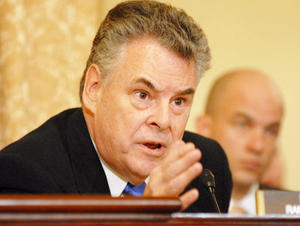Communication interoperabilityFormer high DHS officials, lawmakers oppose new FCC plan for public safety band
Former DHS officials, lawmakers oppose the FCC’s latest plan for reallocating the U.S. limited airwaves; they say the plan could endanger public safety by limiting the ability of first responders to communicate during crises like 9/11

Rep. Peter King (R-NY) attempting to stop the FCC auction of proposed first responder bandwidth // Source: nydailynews.com
Three senior DHS officials in the Bush administration say a federal plan for reallocating the U.S. limited airwaves could endanger public safety by limiting the ability of first responders to communicate during crises like 9/11 (see “FCC asks for public comments on public safety band for first responders,” 21 May 2010 HSNW; and “FCC to move forward with national broadband plan,” 9 April 2010 HSNW).
In a letter to Federal Communications chairman (FCC) Julius Genachowski, former DHS secretary Tom Ridge and two deputies said the FCC’s proposal to auction off a valuable block of spectrum to commercial bidders “seriously shortchanges the first responder community and simply will not give these vital public servants adequate spectrum to do their jobs when it matters most, during times of crisis.”
The Hill’s Sara Jerome writes that the 5 May letter, obtained by the Hill, was also signed by deputies Michael Jackson and James Loy.
Jackson told Jerome in an interview the FCC is squandering an unprecedented opportunity to create a nationwide public safety network with spectrum freed up by the transition from analog to digital television. “The needs of our first responders are substantial and the use of this spectrum, if aggregated in the right way, would be transformational,” he said, calling on the FCC to preserve the “D-Block” chunk of airwaves for a nationwide network all first responders can access.
The security officials’ concerns align with efforts on Capitol Hill to prevent the FCC from proceeding with the auction, tentatively slated for winter 2011.
Representative Pete King (R-New York), the ranking member of the Homeland Security Committee, has introduced legislation to stop the FCC plan, which would sell off the 700 megahertz within the D-Block. King has twenty co-sponsors and is seeking a way to bring companion legislation to the Senate.
Calling the D-Block “ideal” for a public safety network, King said such a network is needed during “large-scale emergencies, such as a terrorist attack.”
On Monday, the Public Safety Alliance, a coalition of safety associations, launched a public relations campaign to stop the auction, contending that the FCC plan is “technically, competitively and operationally flawed.” The group cited King’s bill and called for hearings on why the FCC should allocate the D-Block spectrum to public safety. The National Governors Association has previously called for the D-Block to go to first responders, as has the New York City Police Department.
Jerome writes that FCC spokesman Robert Kenny responded that the agency’s plan builds in the kind of redundancy that public safety may need during disasters by allowing them to access commercial networks when bandwidth demands are high.
He added that the FCC has prioritized the public safety community by providing waivers for states and municipalities to build out their networks and by establishing a center to confront interoperability questions. The FCC’s public safety plan, he notes, is endorsed by Tom Kean and Lee Hamilton, the co-chairs of the 9/11 Commission.
NYPD deputy chief Charles Dowd said, however, that sudden emergencies can cause commercial networks to become overloaded when hundreds of police and firemen within a small radius get on their radios at once. “And I get yelled at by the command staff that they can’t pick up their cell phone calls,” he said.
He also cited interoperability as a concern, noting that when New York City’s police officers traveled south to help out during Hurricane Katrina, they had to bring radios to pass out to officers all over the area to streamline communication. “You don’t want to be in that situation,” he said. “You want to be in a situation where your device works on whatever network you’re on.”
